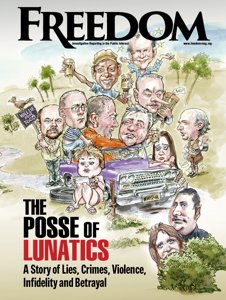
February 20, 2015
Ms. Stephanie S. Abrutyn
Vice President and Senior Counsel,
Litigation and Anti-Piracy
Home Box Office, Inc.
Mr. Jay Ward Brown
Levine, Sullivan, Koch & Schulz, LLP
Litigation and Anti-Piracy
Home Box Office, Inc.
Re: Film by Alex Gibney
Dear Ms. Abrutyn and Mr. Brown:
I am an attorney practicing in the areas of constitutional rights, civil liberties, and First Amendment protections of religious free exercise, speech, and freedom of association. I have represented churches of Scientology for nearly forty years in that capacity. I successfully have argued cases on behalf of the churches, as well as other organizations and persons, in the Supreme Court and most federal circuit courts of appeals. I was co-counsel for the Church of Scientology International in the Headley case that is referred to in the Gibney film, and briefed and argued the case in the United States Court of Appeals for the Ninth Circuit.
Among the numerous inaccuracies, falsehoods and deceptions in the Gibney film is the discussion of the Headley case. Marc Headley was a major focus of Lawrence Wright from the very beginning of his work leading to his book. In the film, Wright states that he “stumbled across” an investigation of the Church concerning allegations the Church “confined” people against their will and engaged in “exploitation of labor and child labor.” Wright also states:
While that investigation was going on, a case was being heard in Colorado, the Headleys, who were suing the Church lor many of these same violations. And the court ruled in that case that these are all essentially practices that are protected by the religious clause of the First Amendment. After that ruling came out, the FBI dropped its investigation. I think it’s an indication that the Church is protected. Wright and Gibney totally ignore what actually happened in the Headley cases (which were litigated in Los Angeles, not Colorado). The true facts disclose that Wright’s suggestion that the Church was engaged in “human trafficking” and confining people against their will, but escaped liability on legal technicalities and law enforcement oversight or “protection,” has no basis in fact. In fact, the federal courts found that the Headleys were not subjected to confinement, imprisonment, or trafficking at all. The federal court decisions came down before Wright published his book, but he never deviated from his reliance on Headley’s false story even after the courts found it to be made of whole cloth. And now Wright and Gibney have conspired to place it at the forefront of Gibney’s film.
The Headleys’ case originally was decided by the United States District Court for the Middle District of California in Los Angeles. In granting summary judgment dismissing Marc Headley’s case, the district court emphasized that Headley “lived outside of [church] premises, and would commute to work on a church bus, a church vehicle, or his own vehicle. [Headley] was allowed to own motorcycles, travel around the world, run errands in Hemet, California, visit friends, and take breaks at work to go home and take care of his dog.” The court made similar findings about his wife Claire. The court then held that, given such circumstances, the First Amendment prohibited any further judicial interference with the Headleys’ voluntary participation in the church as church ministers. The Headleys then appealed to the United States Court of Appeals for the Ninth Circuit. That court affilmed the dismissal of the Headleys’ lawsuit without even reaching the First Amendment issues. Instead, the court found that the Headleys voluntarily participated in their jobs as church ministers and were not coerced to do so. The fact that they worked for the church, as opposed to any other organization, was not determinative precisely because there was no human trafficking whatsoever. The court stated:
Looking back on his time with the Sea Org, Marc testified thus: “I wasn’t saying to myself I’m being held against my will. I think subliminally, I think that I wanted to leave but whether or not I was being held against my will, I don’t think I had those thoughts.” During his Sea Org service, Marc repeatedly said that he enjoyed his experiences with the Church, his promotions, and his work.
Claire testified that, throughout her time with the Sea Org, she served the religion, believed that she was furthering its goals, believed in Scientology, and thought that serving in the Sea Org was the right thing to do. She affirmed that she was a committed Sea Org member for many years. … Claire said that she enjoyed her work and she spoke well of the ministry. She encouraged her siblings to join the Sea Org.
[T]he record overwhelmingly shows that the Headleys joined and voluntarily worked for the Sea Org because they believed that it was the right thing to do, because they enjoyed it, and because they thought that by working they were honoring the commitment that they each made and to which they adhered. We think it telling that the Headleys protest very little about their actual day-to-day jobs with the Sea Org—for Marc, film creation and production; for Claire, management and supervision.
The Headleys have simply not marshaled enough evidence to satisfy the textual demands of section 1589.
Subsequently, the district court ordered the Headleys to pay the church over $40,000 in costs for having brought the lawsuit.
The preliminary investigation to which Wright referred in the film was based entirely upon the false allegations of Headley and other “sources” for Wright and Gibney, mainly Rathbun and Rinder. (Rathbun in fact submitted a declaration to the court in support of the Headleys’ claim, to which the court gave no credence.) As a result of the court decisions, it became clear that the church had not acted in an improper manner. That is why the “investigation” was aborted. It is beyond imagination that a journalist and a film maker would produce works that repeat the allegations of disaffected former members as if they were true, without even mentioning that the federal courts clearly and unambiguously found those allegations to be without basis in fact. And it is especially revealing of the motives and bias of the author and filmmaker that their response is to suggest that somehow the courts and law enforcement agencies were “protecting” the church, rather than properly exercising their duties and functions in rejecting the allegations of the Headleys as without merit.
This further throws into question HBO’s decision to show the Gibney documentary at all, let alone to include the false and misleading references to the Headleys and their meritless claims and case.
Yours very truly,
Eric M. Lieberman







